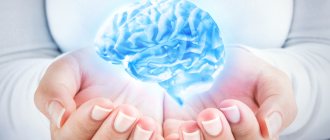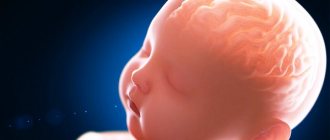1.What does the group of neurodegenerative diseases include?
The term “neurodegenerative diseases” covers the entire set of disorders caused by degenerative changes in the elements of the nervous system - the brain and conductive nerves. Any pathology of this type is characterized by a close connection between organic and functional disorders, and the nature of the latter is determined by the localization of the pathological process and the degree of tissue atrophy of certain parts of the brain.
Neurodegenerative diseases (NDDs) lead to a gradual increase in mental and physical disability. Progressive pathology of the brain as a regulatory center leads to cognitive and motor disorders. At the same time, criticism remains in the initial stages, which entails difficult experiences for the patient from the awareness of his own inferiority. A complex of progressive disorders in NDD may include:
- behavioral disorders;
- movement disorders;
- loss of memory, thinking;
- loss of ability to perceive and comprehend;
- speech disorders;
- imbalance in the emotional-volitional sphere.
Neurodegenerative diseases are characterized by progression, leading to personality degeneration, complete loss of ability to work and legal capacity. As a rule, the death of patients occurs after several (sometimes tens) years from additional diseases, which can partly be associated with increasing difficulties in caring for and serving such patients.
A must read! Help with treatment and hospitalization!
Pain in the spine (dorsopathies)
Dorsopathies in medicine refer to a variety of pain in the back (and limbs) caused by degenerative-dystrophic diseases of the spine.
If the patient experiences pain for longer than 12 weeks, it is called chronic. The causes of dorsopathies are clarified based on the results of MRI of the spine (CT is most often only an auxiliary method). Treatment is carried out by neurologists, osteopaths, algologists or spinal neurosurgeons.
Degenerative-dystrophic diseases of the spine often lead to compression of the nerve endings and roots of the spinal cord, so the pain syndrome can be very intense and spread to other associated parts of the skeleton: arms, feet, chest, etc.
Thus, problems with the spine are indicated not only by dorsopathies localized in the back area, but also by other pains - with irradiation and neuralgic symptoms, for example:
- Symptom of intermittent claudication;
- “Shooting” pain in the leg;
- Numbness in the arms or legs;
- Dizziness and headaches;
- Weakness of the limbs, marked decrease in muscle tone;
- Loss of sensation in limbs.
As a rule, pain becomes more intense after physical activity and goes away during rest, but it also happens the other way around, when it is at rest that the patient begins to experience pain.
DDZD of the cervical spine causes pain in the neck and forearm, paresis of the arms, headaches and dizziness, tinnitus and blurred vision.
DDSD of the thoracic spine can manifest as pain behind the sternum, which intensifies with breathing and coughing. The pain spreads along the ribs with radiation to the back. The symptoms are somewhat reminiscent of angina pectoris.
DDSD of the lumbosacral spine is associated with intense lower back pain radiating to the legs (numbness, weakness, lameness). It becomes difficult for the patient to play sports, walk, bend over, or remain in a static position for a long time.
2.Causes of neurodegenerative diseases and risk factors
The exact cause that provokes the onset of pathology has not been identified for any neurodegenerative disease. There are some characteristic background conditions inherent in one or another combination in patients with NDD. The most frequently identified trends are:
- disruptions in the metabolism and synthesis of certain proteins that make up the myelin sheath of neurons (their lack or excessive accumulation);
- disturbances in the activity of receptors of brain structures associated with neurotransmitter regulation;
- genetic predisposition, presence of relatives with neurodegenerative diseases;
- intoxication and death of neurons against the background of concomitant pathological processes or under the influence of constantly acting negative factors (free radicals, herbicides, pesticides, alcohol and drugs).
In addition, many pathologies affecting metabolic processes are recognized as indirect risk factors:
- infections;
- obesity;
- head injuries;
- diseases of the cardiovascular system;
- chronic endocrine disorders;
- renal and liver failure as a mechanism for removing toxins;
- all bad habits;
- low physical and intellectual activity.
Visit our Neurology page
Neurodegeneration
By Serge Przedborski, Mikel Vila and Vernice Jackson-Lewis
Per. from English N.D. Firsova (2018)
Neurodegeneration is a widely used term whose meaning is believed to be widely understood. Yet finding a precise definition of neurodegeneration is more difficult than one might imagine. Neurodegeneration is often mentioned only incidentally and is barely discussed in mainstream medical textbooks or even fully defined in the most comprehensive dictionaries. Etymologically, the word consists of the prefix "neuro", which denotes nerve cells, that is, neurons, and the word "degeneration", which refers, in the case of tissues or organs, to the process of their loss of structure or function. Thus, in the strict sense of the word, neurodegeneration corresponds to any pathological condition that primarily affects neurons. In practice, neurodegenerative diseases represent a large group of neurological disorders with heterogeneous clinical and pathological manifestations affecting specific subsets of neurons in specific functional anatomical systems; they arise for unknown reasons and progress steadily. Conversely, neoplasms, edema, hemorrhages, and injuries to the nervous system that are not primary neuronal diseases are not considered neurodegenerative disorders. Diseases of the nervous system that are not associated with neurons per se, but rather with their derivatives, such as the myelin sheath, as seen in multiple sclerosis, are also not neurodegenerative disorders or pathologies in which neurons die as a result of a known cause such as hypoxia. poison, metabolic defects or infections.
Among hundreds of different neurodegenerative disorders, only a few have received the lion's share of attention so far, mainly Alzheimer's disease, Parkinson's disease, Huntington's disease and amyotrophic lateral sclerosis. Many of the less common or widespread neurodegenerative disorders, although no less devastating, are largely ignored.
The most consistent risk factor for developing a neurodegenerative disorder, especially Alzheimer's disease or Parkinson's disease, is age. Over the past century, the growth rate of the population aged 65 years and over in industrialized countries has significantly exceeded the growth rate of the population as a whole. Thus, the proportion of older citizens can be expected to double over the next generations, and the proportion of individuals suffering from any neurodegenerative disorder is likely to increase. This forecast is at the center of growing concern among the medical community and legislators, as the increasing emotional, physical, and financial burden associated with these disabling diseases on patients, caregivers, and society can be easily anticipated. Compounding the problem is the fact that while there are several approved medications today that provide some relief from the symptoms of some neurodegenerative diseases, their chronic use is often associated with debilitating side effects, and none stop the progression of the degenerative process. The development of effective preventative or protective treatments is hampered by our limited knowledge of the causes and mechanisms by which neurons die in neurodegenerative diseases. Despite this grim outlook, several neurobiological discoveries have brought the day closer than ever before when the secrets of several neurodegenerative disorders will be unlocked and effective therapeutic strategies will become available.
This Perspective series will review selected genetic and molecular advances relevant to the biology of neurodegeneration, such as apoptosis, oxidative stress, and mitochondrial dysfunction. While some of these will be discussed in terms of the general mechanisms underlying neuronal death, others will be discussed in the context of a specific disease such as amyotrophic lateral sclerosis or Huntington's disease. From multiple perspectives, this series provides readers with comprehensive information about prominent neurodegenerative diseases from both a clinical and molecular perspective. As a preamble to the series, however, it would be useful to discuss some general concepts related to neurodegeneration, which should help set the stage for more detailed reviews.
Classification of neurodegenerative diseases
The number of neurodegenerative diseases is currently estimated to be several hundred, and among them, many appear to overlap each other clinically and pathologically, making their practical classification quite difficult. This problem is further complicated by the fact that in diseases such as multiple system atrophy, where multiple areas of the brain are affected, different combinations of lesions can lead to different clinical pictures. In addition, the same neurodegenerative process, especially at the onset, can affect different areas of the brain, making the disease highly variable in terms of symptoms. Despite these difficulties, the most popular classification of neurodegenerative disorders is still based on the predominant clinical feature or the topography of the predominant lesion, and often a combination of both. Accordingly, neurodegenerative disorders of the CNS may, for example, first be grouped into diseases of the cerebral cortex, basal ganglia, brainstem and cerebellum or spinal cord. Within each group, the disease can then be further classified based on its main clinical features. For example, the group of diseases that primarily affect the cerebral cortex can be divided into dementia-causing (eg, Alzheimer's disease) and non-dementia-causing diseases. It should be noted that although Alzheimer's disease is the most commonly cited cause of cortical dementia, dementia appears to occur in at least 50 different diseases. Moreover, dementia is not limited to neurodegenerative diseases; it also often accompanies ischemic, metabolic, toxic, infectious and traumatic brain lesions.
Disorders that predominantly involve the basal ganglia (a number of deep nuclei located at the base of the forebrain, including the caudate nucleus, globus pallidus, substantia nigra, subthalamic nucleus, red nucleus, and some thalamic and brainstem nuclei) are essentially characterized by movement disorders. Based on the phenomenology of abnormal movements, basal ganglia diseases can be classified as hypokinetic or hyperkinetic. Hypokinetic disorders of the basal ganglia are embodied in the form of Parkinson's disease, in which the amplitude and speed of voluntary movements are reduced or, in extreme cases, even absent, resulting in the patient becoming a prisoner in his own body. In addition to Parkinson's disease, there is parkinsonism, which is associated with at least two of the following clinical signs: resting tremor, slowness of movement, rigidity and postural instability; it is also found in a variety of other basal ganglia diseases. In some cases (eg, striatonigral degeneration), only parkinsonism is present, but in others, often called "parkinson plus" syndromes, there is parkinsonism plus features of cerebellar ataxia (eg, olivopontocerebellar atrophy), orthostatic hypotension (eg, Shy-Drager syndrome), or paralysis vertical eye movements (eg, progressive supranuclear palsy). Because parkinsonism may be the only clinical manifestation of parkinson plus syndromes early on, it is difficult to make an accurate diagnosis until the patient reaches a later stage of the disease. This problem is well illustrated by the fact that more than 77% of patients with Parkinson's disease will be diagnosed with Parkinson's disease in their lifetime, but a quarter of them will have lesions inconsistent with Parkinson's disease at autopsy. At the other end of the spectrum are hyperkinetic disorders of the basal ganglia, which manifest as Huntington's disease and essential tremor. In these two diseases, excessive abnormal movements, such as chorea or tremors, superimpose and interfere with normal voluntary movements. Although hyperkinetic basal ganglia disorders are probably as diverse as hypokinetic ones, their precise classification, even across the lifespan, is less problematic, in part because for some of these syndromes there are specific disease markers, particularly gene mutations.
The classification of neurodegenerative diseases of the cerebellum and related structures is particularly challenging due to the striking overlap between different pathological conditions. Indeed, some cerebellar diseases can easily be grouped into three main neuropathological types: cerebellar and cortical atrophy (lesions involving Purkinje cells and inferior olives), pontocerebellar atrophy (lesions involving the cerebellum and pons), and Friedreich's ataxia (lesions involving the posterior spinal column, peripheral nerves and heart). However, some other diseases of the cerebellum and related structures cannot be classified into any of these categories, such as cerebelloranguclear degeneration, in which the most prominent lesions are in the dentate and red nuclei, and Machado-Joseph disease, in which in which degeneration affects the lower and upper motor neurons, the substantia nigra and the dentate gyrus.
Neurodegenerative diseases that primarily affect the spinal cord include amyotrophic lateral sclerosis and spinal muscular atrophy, in which the most severe lesions are found in the anterior part of the spinal cord, and the already mentioned Friedreich's ataxia, in which the most severe lesions are found in the posterior part of the spinal cord. Finally, there is one group of neurological diseases that are often, but not always, considered neurodegenerative due to their chronicity and unknown etiopathogenesis, but which, unlike those described above, do not show obvious structural abnormalities. These include torsion dystonia, Tourette's syndrome, essential tremor and schizophrenia. Various brain and electrophysiological studies have revealed significant functional deficits in all of these single neurodegenerative disorders, but have not yet allowed us to uncover their chemical neuroanatomical substrates.
Over the past two decades, significant advances in neurohistological techniques such as immunohistochemistry have replaced or complemented many classical histological approaches. Undoubtedly, these new methods have improved the sensitivity and specificity of neuropathological diagnostic criteria and, consequently, the accuracy of classification of neurodegenerative disorders. However, although these new methods can now determine the presence of certain inclusions or deposits or the degree of gliosis in certain areas of the brain, none of the already improved classifications of neurodegenerative diseases are completely satisfactory. On the other hand, the inclusion of the latest basic science techniques, such as gene array, PCR, Western blot, and laser microdissection, into our arsenal of neuropathological diagnostic tools should provide new clues as to how to effectively classify neurodegenerative diseases. Based on the use of some of these new technologies, a new school of thought favors classification not by the neuropathological features of diseases, but by their molecular characteristics. In this new approach, neuropathological entities that previously belonged to very different categories are grouped together based on a common molecular defect. For example, Huntington's disease, spinal cerebellar atrophy, and myotonic dystrophy fall into the category of trinucleotide repeat disorders; Creutzfeldt-Jakob disease, Gerstmann-Straussler-Scheinker syndrome, and fatal familial insomnia fall into the category of prion diseases; Parkinson's disease, progressive supranuclear palsy and diffuse dementia with Lewy bodies fall into the category of synucleinopathies; and corticobasal degeneration, frontotemporal dementia with parkinsonism linked to chromosome 17 (FTDP-17), and Pick's disease are categorized as tauopathies. Although the jury is still out on whether this new classification will mitigate previous concerns, we believe that it promises to be less ambiguous and more clinically and therapeutically practical.
Source:
- The Journal of Clinical Investigation, 2003 Jan 1; 111(1): 3–10
3.Diagnostics and clinical picture of neurodegenerative diseases
At the initial stages, different NDDs may have a similar clinical picture. Diagnosis should be based not only on the collection of anamnestic data and dynamic observation, but also include genetic aspects. Special tests help differentiate a specific diagnosis. To exclude tumor, traumatic, vascular origin of the onset of disorders, instrumental diagnostic methods are used.
The following examination methods for suspected NDD are most indicative:
- MRI, CT scan of the brain;
- PAT;
- single-photon CT;
- study of the level of neurotransmitters;
- angiography;
- Doppler ultrasound of the vessels of the brain and cervical spine;
- EEG.
Clinical manifestations of neurodegenerative diseases depend on the stage and specific type of pathology. Most often, the symptom complex includes motor disorders (changes in gait, tremor, akinesia and rigidity). Postural instability often develops as the disease progresses. Hyperkinesis, spontaneous or violent movements are possible.
In the level of intelligence, there is dementia, weakening of memory, mental activity, and contacts with others are disrupted. As a result, the sick person gradually isolates himself. For making a diagnosis, the fact of primary impairment of motor activity or intelligence is often indicative. Muscle activity remains intact in the initial stages of Alzheimer's disease, vascular dementia, and Pick's disease. While Parkinson's disease and Huntington's chorea initially manifest themselves as changes in gait, tremor, and hyperkinesis.
About our clinic Chistye Prudy metro station Medintercom page!
Osteochondrosis
Behind the term “osteochondrosis” is a large group of pathologies that lead to degenerative processes affecting the intervertebral discs. As a result, they become smaller, delaminate, lose elasticity and ultimately rupture, leading to the formation of a protrusion or intervertebral hernia.
Osteochondrosis is considered to be the starting point for the development of other DDDDs, but in itself it is not their cause. A predisposition to osteochondrosis can be hereditary, but more common causes include metabolic disorders, posture and physical inactivity (weak back muscles, poor circulation and, accordingly, nutrition of the intervertebral discs).
4. Course of the disease and care for patients with NDD
The steady progression of diseases associated with neurodegeneration leads such patients to disability. They are susceptible not only to disorders of intelligence, memory and thinking, but are also defenseless against increasing motor disorders. Loss of healthy motor coordination often leads to injury. The autonomic nervous system, under the “guidance” of the diseased brain, begins to malfunction, leading to digestive disorders, dry skin, constipation, and urination problems.
The capacity of patients with neurodegenerative diseases is also always a controversial issue. Many of them are capable of antisocial behavior and pose a threat to themselves and others.
Treatment of NDD is always nonspecific and is aimed at providing symptomatic care, providing proper care for the patient, and preserving for as long as possible the patient’s ability to interact with those who take him under their care. At more severe stages, the main tasks are feeding, hygiene, prevention of infections and injuries, as well as bedsores and other complications.
What are the types of degenerative-dystrophic diseases of the spine?
A large group of degenerative-dystrophic diseases of the spine are united by at least three characteristics:
- DDSDs are potentially chronic diseases. In the absence of adequate therapeutic and conservative measures, the negative effects increase over time.
- Most degenerative diseases of the spine are associated with the natural aging of osteochondral tissue, but its destruction, thinning, and fragility can also be caused by other reasons (sports or household injury, physical inactivity, metabolic disorders, congenital connective tissue dysplasia).
- Some DDSDs, such as spinal stenosis, intervertebral hernias, and tumors lead to compression of the nerve endings or roots of the spinal cord. This causes a gross disruption of the biomechanics of the human body, muscle atrophy, weakness of the limbs, lameness, as well as intense pain, which can lead to depression.
Depending on the location, it is customary to distinguish degenerative-dystrophic diseases:
- Cervical spine;
- Thoracic spine;
- Lumbosacral spine.
The localization of DDZP influences treatment tactics.
Degenerative-dystrophic diseases of the spine include:
- Osteochondrosis;
- Intervertebral hernia;
- Protrusion;
- Spondylosis;
- Spondyloarthrosis;
- Spondylolisthesis;
- Spinal stenosis;
- Spinal cyst;
- Osteophytes;
- Spondylosis;
- Spinal osteoporosis;
- Sacroiliitis;
- Myofascial syndrome;
- Facet syndrome (facet joint syndrome).
Degenerative lesions look like this in stages:
- the amount of moisture in the cartilage decreases - it loses functionality;
- chondrocytes in cartilage tissue partially die and are not restored;
- the amount of protein glycons decreases – mainly chondroitin;
- blood circulation in the articular ends of bones is impaired;
- the biochemical composition of the synovial fluid changes;
- cartilage experiences even more moisture deficiency, loses elasticity, and becomes less stable;
- in the joint the balance of damage and recovery processes is disturbed - in the direction of damage;
- degenerative lesions start – arthrosis begins.
The whole process takes years. A person has no idea that his joints are damaged and deteriorating. At certain stages, it is still possible to stop the destruction and restore the water balance with the help of a synovial fluid prosthesis. Sometimes it is enough to increase your daily water intake to normal. But, if arthrosis has already been diagnosed, treatment cannot be avoided.
Every glass of beer instead of a glass of clean water is another step towards arthrosis
Osteophytes of the spine
Osteophytes are hard, abnormal growths on the bone tissue around a vertebra. Such growths have a jagged shape and can painfully compress nerve endings and narrow the lumen of the vertebral foramen. Sometimes osteophytes are formed from the tissues of dead ligaments. In most cases, they do not affect quality of life due to their small size. However, if osteophytes grow over time, they ultimately cause acute compression, damage to surrounding tissue, and inflammation. Symptoms of spinal osteophytes are dull pain in the back or neck, which intensifies when walking or standing (sometimes radiating to the leg or arm) and paresis. In this case, osteophytes require surgical removal. If they are found along with the operated hernia, they can complicate surgical tactics, so in this case they are also removed.
Spinal neoplasms
Spinal tumors can be benign or malignant. The prevalence of the latter is relatively low, and most often it is not bone cancer that is diagnosed, but spinal cord cancer, which paralyzes the entire human body.
As benign tumors grow, they can also have disabling consequences. Neoplasms can compress nerve fibers and roots of the spinal cord, causing pain, neuralgia, and muscle atrophy.
Spinal injuries, bone diseases, and heredity increase the risk of spinal tumors.
Benign tumors of the spine include:
- Osteoma - develops from bone cells in the pedicles of the posterior part of the vertebra. It manifests itself as back pain, which bothers you at night. They are poorly visualized on X-ray; the only accurate method of visualizing them is CT.
- Bone cyst - a tumor forms on the back of the vertebra or affects it completely. Most often found in the cervical spine. If there are compressions, they are removed surgically.
- Giant cell tumors are formed primarily from bone cells and represent a deviation from their normal development. They reach large sizes and therefore cause pain. They are removed surgically and require pre- and postoperative monitoring, as they can degenerate into a malignant tumor of the spine.
- Granuloma is a spinal tumor, usually small in size. Accompanying damage to the vertebra, namely the thinning of its body. Vertebral granuloma can be an independent disease, or it can indicate malfunctions and damage to other organs. Treatment is carried out using surgical or radiation methods.
Malignant neoplasms of the spine include:
- Metastases are secondary foci of oncology, formed from malignant cells that migrated from other organs, bones and joints through the circulatory system or lymph flow. As a rule, the primary focus is located close, and depending on the segment of the spine, it can be the lungs, abdominal cavity, mammary gland, prostate gland, etc.
- Osteogenic sarcoma is a malignant tumor of bone tissue. Common among children (adolescents) and elderly patients.
- Myeloma (or multiple myeloma) is a malignant tumor of bone tissue. Multiple myeloma often affects not only the spine, but also other osteochondral structures. The highest prevalence of the disease is among patients over 40 years of age.
A CT scan revealed a degenerative disease of the spine - what to do?
If back pain does not bother you, but the “accidental finding” on a CT or MRI turned out to be “degenerative-dystrophic disease of the spine,” you should clarify what kind of disease it is and assess the possible health risks in the future.
Timely consultation with a neurologist or osteopath will help develop measures for effective treatment of DDSD and prevention of complications. The worst option would be to ignore the problem and “let go” of the situation to the point of traumatic consequences and the need for surgical intervention.
If there is severe pain associated with an intervertebral hernia, stenosis or other type of DDSD, the patient should consult a neurologist, algologist or neurosurgeon. The pain must be relieved, as it makes it difficult to move and provokes the development of depression, thus aggravating the situation. The patient will also be prescribed therapy (NSAIDs, therapeutic blockades, exercise therapy, radiofrequency ablation, physiotherapy, etc.) or surgery will be recommended.
Spondylolisthesis of the vertebral segment
Spondylolisthesis is an abnormal displacement or slipping of a vertebra. As a result, the spinal segment loses stability. The consequences can be traumatic and dangerous - sometimes the displacement of one vertebra in relation to another (upper to lower) reaches 75%.
Spondylolisthesis of the spinal segment can be a consequence of injury, surgery, improper bone development, systematic improper loads, and diseases of the osteochondral tissue. Causes pain (passes after rest) with neuralgic symptoms, dysfunction of the pelvic organs.
To stabilize the spinal segment, the patient may be indicated for neurosurgical surgery with the installation of an implant, metal structure, or interbody cage.
Spinal stenosis
Stenosis is a pathological narrowing of the spinal canal caused by hyperplasia of bone tissue, tumor growth, and the entry of fragments of osteochondral fragments during injury into the space occupied by the roots of the spinal cord or nerve fibers, which leads to their compression. Spinal stenosis manifests itself as pain with neuralgic symptoms. The most common complaint is back pain, which increases with walking and decreases with sitting (flexing the spine). An accompanying symptom is most often numbness and weakness of the legs, pain of a “shooting” nature. The latter is typical for lesions of the lumbosacral segment.







